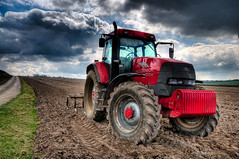If U.S. Representative Rosa DeLauro (D-CT) has her way, the nation’s farms and vineyards–under the umbrella of small business operations–would be grouped with slaughterhouses and restaurants and face new regulations under the proposed Food Safety Modernization Act of 2009.
The underlying purpose of H.R. 875 is noble; the Food and Drug Administration is tasked with overseeing […]
—
Thank you for reading! If you enjoyed this, please consider following more tips by RSS or email delivery. | Twitter | FriendFeed | Email
 If U.S. Representative Rosa DeLauro (D-CT) has her way, the nation’s farms and vineyards–under the umbrella of small business operations–would be grouped with slaughterhouses and restaurants and face new regulations under the proposed Food Safety Modernization Act of 2009.
If U.S. Representative Rosa DeLauro (D-CT) has her way, the nation’s farms and vineyards–under the umbrella of small business operations–would be grouped with slaughterhouses and restaurants and face new regulations under the proposed Food Safety Modernization Act of 2009.
The underlying purpose of H.R. 875 is noble; the Food and Drug Administration is tasked with overseeing 70-year-old laws and it is necessary to create a second agency under the U.S. Department of Health and Human Services called the Food Safety Administration so the FDA can be reformed into a more drug-centric agency. However, breaking one agency into two is not the crux of the bill, for there are new pieces of legislation introduced therein.
Of note, bloggers are reacting to the inclusion of “food production facilities,” comprised of “any farm, ranch, orchard, vineyard, aquaculture facility, or confined animal-feeding operation,” as an unfair match to existing government controlled food establishments. Food & Water Watch compiled the background and facts on the bill.
Perusing through section 206, it’s easy to see why many dread the potential closure of farmers’ markets and community supported agriculture movements, many of which are the direct result of organic farmers who run small operations.
 Section 206 calls for farms–such as local operations at Arrowhead Farm, Colby Farm, and Cider Hill Farm–to be responsible for a “written food safety plan,” adherence to “minimum standards related to fertilizer use, nutrients, hygiene, packaging, temperature controls, animal encroachment, and water,” and to be victims of “monitoring and surveillance of animals, plants, products, or the environment, as appropriate.”
Section 206 calls for farms–such as local operations at Arrowhead Farm, Colby Farm, and Cider Hill Farm–to be responsible for a “written food safety plan,” adherence to “minimum standards related to fertilizer use, nutrients, hygiene, packaging, temperature controls, animal encroachment, and water,” and to be victims of “monitoring and surveillance of animals, plants, products, or the environment, as appropriate.”
Blogger Alan of an eco-friendly farm in Ohio, Roberts Roost, agrees it is important for the small farm producer and its customers’ voices to be heard:
All food establishments are required to register and to be subject to random inspection based on their classification (category 1 being inspected the most often and so on through category 5). Here is one of the places that the small farmer could get into all kinds of trouble. Most small farms are also food processors.
On my farm, for example, we harvest and package various kinds of salad greens. That would put us in the Category 3 Food Establishment. That would require that I build a separate “processing” facility to package my salad greens. That facility would have to meet certification requirements from the state, and now federal inspectors, as well as OSHA, etc. I would also be subject to at least monthly inspections, and a mountain of record keeping.
I sell to about 150 people a week, all of whom know me, my farm, my methods. My produce doesn’t really enter the conventional food system. Yet I would have to meet all these requirements (I’m sure there are more).
A giant salad greens farm in California who cuts and sells their lettuce to a processing facility would be exempt from these requirements. Everything I do on my farm meets the requirement of at least a Category 5 Food Establishment and subjects me to these requirements. Most large producers would be exempted.
In other words, while large farms would be able to support these new standards with a snap of the finger, the smaller farming operations face the potential of closure from burdensome paperwork. If farms existed in this country for 300+ years and nobody’s fallen sick, why the new regulations?
Photo credits: Dan Maudsley and Andrew Stawarz
—
Thank you for reading! If you enjoyed this, please consider following more tips by RSS or email delivery. | Twitter | FriendFeed | Email






